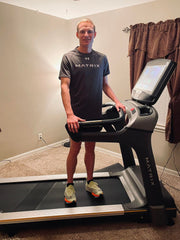High blood sugar is a risk factor for further metabolic issues, especially type 2 diabetes. The onset of these metabolic issues may cause symptoms such as fatigue or excessive thirst. Regular blood tests are important to help us identify blood sugar issues as early as possible.
One of the most common blood tests is the HbA1c, which measures the percentage of red blood cell proteins that are coated in sugar (aka glycated hemoglobin). Your red blood cells live about 70─120 days. The HbA1c percentage relates to your average blood sugar levels over the previous two to three months. From the physician’s point of view, the test shows a more long-term measure. Meaning, patients can’t “cheat” the test with just a few days of healthier food choices prior to their blood draw.

HbA1c recommendations
The CDC recommends that those over 45 years of age take HbA1c tests to screen for diabetes and pre-diabetes. Every one to three years this test can be repeated to ensure your blood sugar regulation is in a healthy range.
Healthy HbA1cs range from 4─5.6%, whereas 5.7─6.4% suggests prediabetes, and 6.5% and above suggests diabetes. Even though HbA1cs reflects your average blood sugar value, your physician may use additional tests to determine whether you have diabetes. The good news is that healthier daily habits can reduce HbA1c in most individuals.
HbA1c limitations
One of the limitations is that this measure fails to capture the magnitude of blood sugar changes throughout you day. This amount of variance differs from person-to-person depending on many factors (such as dietary sugars and level of physical activity). HbA1c may not reflect that some of us have more stable blood sugar throughout the day than others, but since blood sugar influences mood and fatigue, it’s a good idea to adopt the habits that will reduce blood sugar spikes.
How exercise protects blood sugar
Exercise is a proven way to gain better control over your blood sugar. There are many reasons for this, but a simple fact is that when you exercise, working muscles pull in sugars directly from the bloodstream to metabolize as fuel. Your muscles are the largest sugar “sink” in the body, capable of pulling in more sugar at a faster rate than any other tissue.

More daily movement can also help your body remain sensitive to the actions of insulin, a hormone that prevents high blood sugar. Exercise is so important for protecting insulin sensitivity that some experts have stated that “physical training can be considered to play an important, if not essential role in the treatment and prevention of insulin insensitivity.”
Blood sugars may be poorly regulated because we become less sensitive to insulin when blood sugars remain high for several years. Then eventually, insulin levels may plummet. This reflects that insulin-producing cells have been damaged and lost, and unfortunately these cells do not regenerate.
Those who exercise are likely to remain sensitive to insulin. This helps the body maintain steady energy levels throughout the day.
A single workout benefits blood sugar
Daily blood sugar swings aren’t captured by the HbA1c test, but they can be measured by continuous blood sugar monitoring. Devices may be attached to an individual to observe how their blood sugar changes throughout the day. These devices make it possible to gauge the effectiveness of different treatments. And they reveal the impressive advantages of exercise.

Are you on the fence about working out today? You should know that even a single workout can benefit blood sugar regulation! This benefit occurs across many body-types, ages and conditions, for example:
- Even if you already have type 2 diabetes, studies show that a 30-minute workout of moderate intensity will reduce high blood sugar for that day and the following day!
- Whether you are leanor carry a high amount of excess body fat, even one workout improves your sensitivity to insulin.
Both cardio endurance and strength resistance workouts enhance insulin sensitivity and benefit blood sugar regulation. Even though diet changes are effective alone, the best results include changing dietary sugars while also focusing on the regular physical activity.
To learn more about World Diabetes Day and access resources, including a Diabetes Risk Assessment Quiz, and free Understanding Diabetes Online Course, visit World Diabetes Day.
_______________________________________________________________
About the Author
Karlie Intlekofer, PhD, CNC, CPT, Global Wellness Researcher, Matrix Fitness

As the Global Wellness Researcher at Matrix Fitness, Karlie uses evidence-based practices to develop exercise programming and initiatives to support healthier daily habits. As a neuroscientist specializing in behavior and exercise science, she focuses on the benefits of exercise, nutrition and habit formation for brain health and well-being. Karlie earned her doctorate in Neuroscience and Behavior and bachelor’s degree in Health and Exercise Science.
Disclaimer: This blog post is for informational and educational purposes only and does not substitute for professional medical advice. The above information should not be used to diagnose, treat or prevent any disease or medical condition. Seek the advice of your health care provider before making changes to your diet, daily activity, sleep or fitness routine and any questions you may have regarding your health or a medical condition. Matrix Fitness assumes no responsibility for any personal injury or damage sustained by any recommendations, opinions or advice given in this article. Always follow the safety precautions included in the owner's manual of your fitness equipment.










































